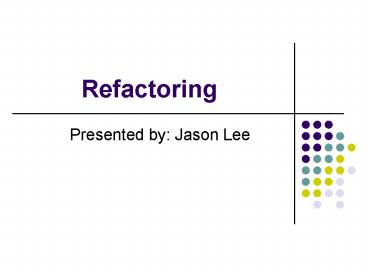Refactoring - PowerPoint PPT Presentation
1 / 17
Title:
Refactoring
Description:
Change the structure, not the behavior. Example: (x2-1) = (x 1)(x-1) Cleans up ' ... Frank Lloyd Wright. How do we refactor? Manual Refactoring. Code Smells ... – PowerPoint PPT presentation
Number of Views:21
Avg rating:3.0/5.0
Title: Refactoring
1
Refactoring
- Presented by Jason Lee
2
Overview
- Defining Refactoring
- Justification
- Methodologies and Best Practices
- Examples
- Future Work
- Questions
3
What is Refactoring?
- Code reorganization
- Implies equivalence
- Change the structure, not the behavior
- Example (x2-1) (x1)(x-1)
- Cleans up messy code
- Does NOT fix bugs
4
Refactoring and XP
- XP uses extreme levels of good programming
practices - The core practices of XP
- Pair programming
- Refactoring
- Testing
- Continuous integration
- Evolutionary design
5
Costs and Benefits
- Costs
- Resource overhead
- Requires experience
- Benefits
- Improves understandability
- Simplifies testing
- Uncovers bugs
- "The two most important tools an architect has
are the eraser in the drawing room and the sledge
hammer on the construction site." - Frank Lloyd Wright
6
How do we refactor?
- Manual Refactoring
- Code Smells
- Automated/Assisted Refactoring
- Refactoring by hand is time consuming and prone
to error - Eclipse (www.eclipse.org)
- .NET Refactoring (www.dotnetrefactoring.com)
- In either case, test your changes
7
Code Smells
- A hint that something is wrong
- Detection comes with experience
- Table of common smells
- http//wiki.java.net/bin/view/People/SmellsToRefac
torings
8
Code Smell Examples
- Too much code
- Methods that are too big
- Duplicated code
- Code that is not executed
- Not enough code
- Classes with little code
- Empty catch clauses
- Outside the code
- Excessive logging
- Excessive commenting
9
Best Practices
- Refactor in small steps
- Do not change interface and implementation
simultaneously - Minimize sources of error
- Test continuously
- Refactor with a purpose
10
Refactoring Examples
- Renaming methods and variables
- Extracting methods
- Replace conditionals with polymorphism
- Hide implementation with interface
11
Example 1Expansion and Contraction
- Gray bars denote duplicated code
12
Example 2Collapsing Hierarchy
- Centralize related behavior into single class
13
Example 3Indirection
- Removes direct dependency of client code from the
feature
14
Future Work
- Refactoring noses
- Refactoring SE artifacts
- Inclusion into classical models of SE
- Scalable refactoring
15
Summary
- Refactoring does not affect behavior
- Gaining experience and confidence is necessary
- Use tools to reduce errors
- Each behavior should do all of one thing, do one
thing well, and do only one thing
16
References
- 1 Smith, Suzanne, and Stoecklin, Sara. What We
Can Learn from Extreme Programming. Consortium
for Computing in Small Colleges, 2001. - 2 Fowler, Martin. Refactoring. ICSE 02, May
19-25, 2002. - 3 Fowler, Martin. Refactoring Home Page.
www.refactoring.com - 4 Mens, Tom, et al. Refactoring Current
Research and Future Trends. LDTA 03 Preliminary
Version, 2003. - 5 Wikipedia Refactoring. http//en.wikipedia.or
g/wiki/Refactoring - 6 Wiki Pages about Refactoring.
http//c2.com/cgi/wiki?WikiPagesAboutRefactoring
17
Questions
?

